Module 6 A trip to the zoo (Language points)(共13张PPT)
文档属性
| 名称 | Module 6 A trip to the zoo (Language points)(共13张PPT) |  | |
| 格式 | zip | ||
| 文件大小 | 184.1KB | ||
| 资源类型 | 教案 | ||
| 版本资源 | 外研版 | ||
| 科目 | 英语 | ||
| 更新时间 | 2022-10-10 19:23:24 | ||
图片预览

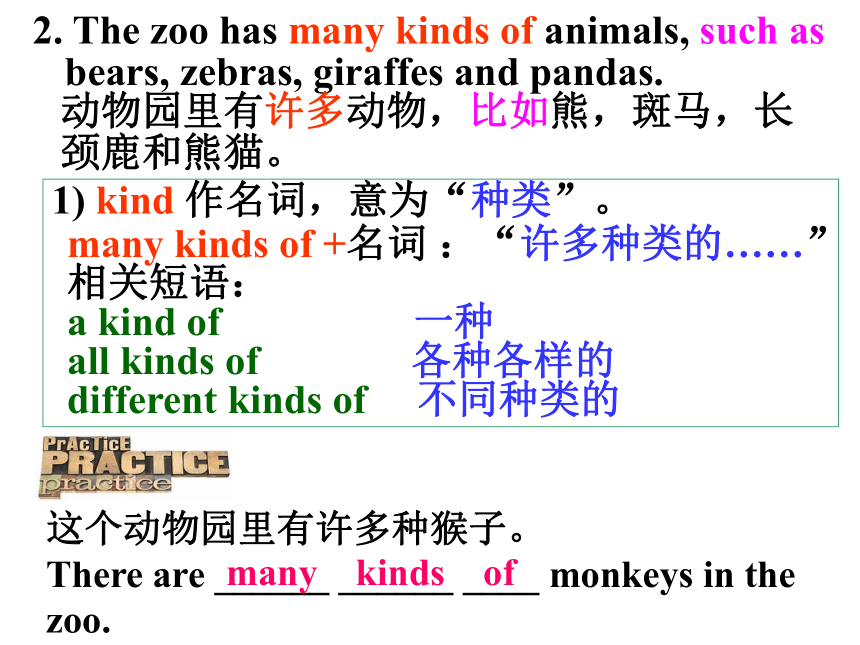
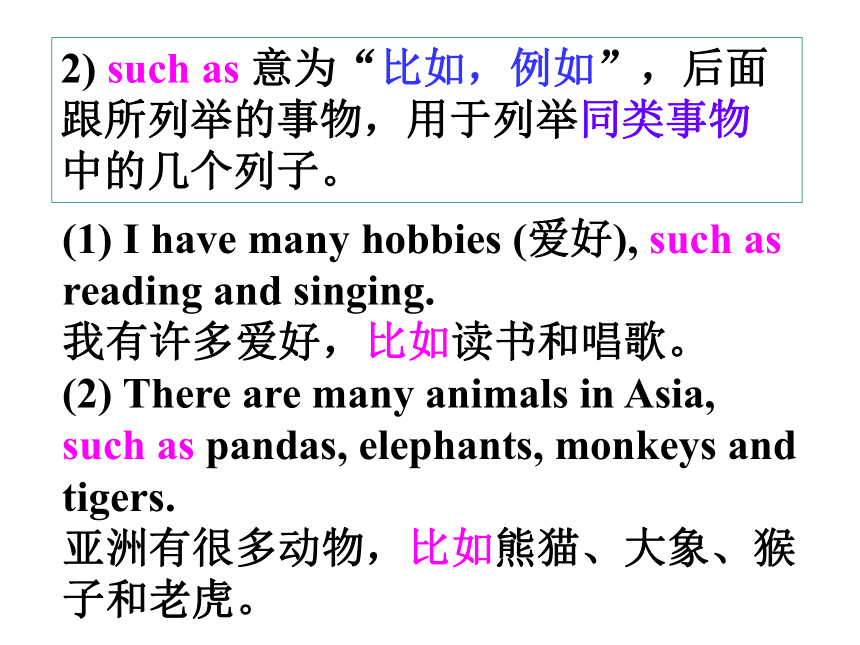
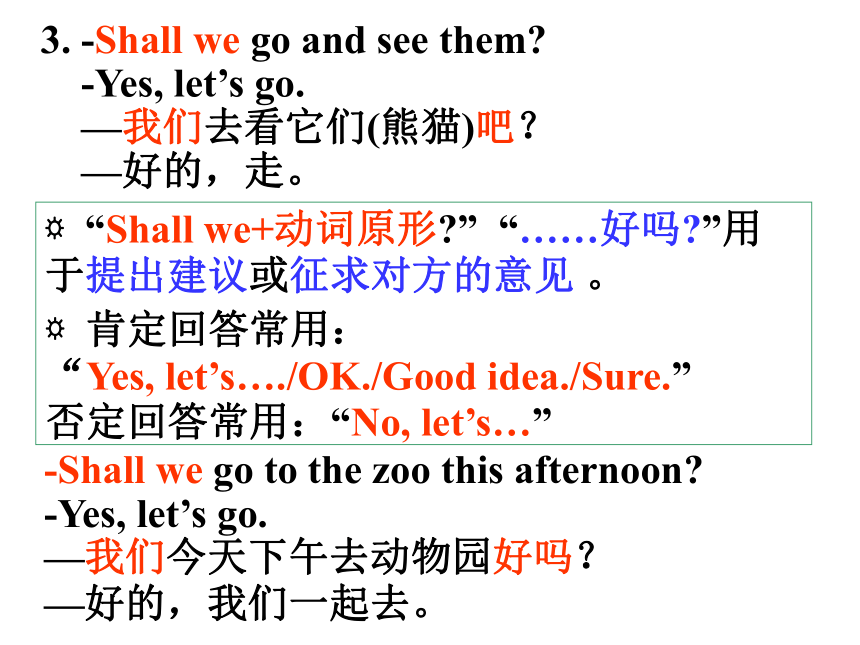
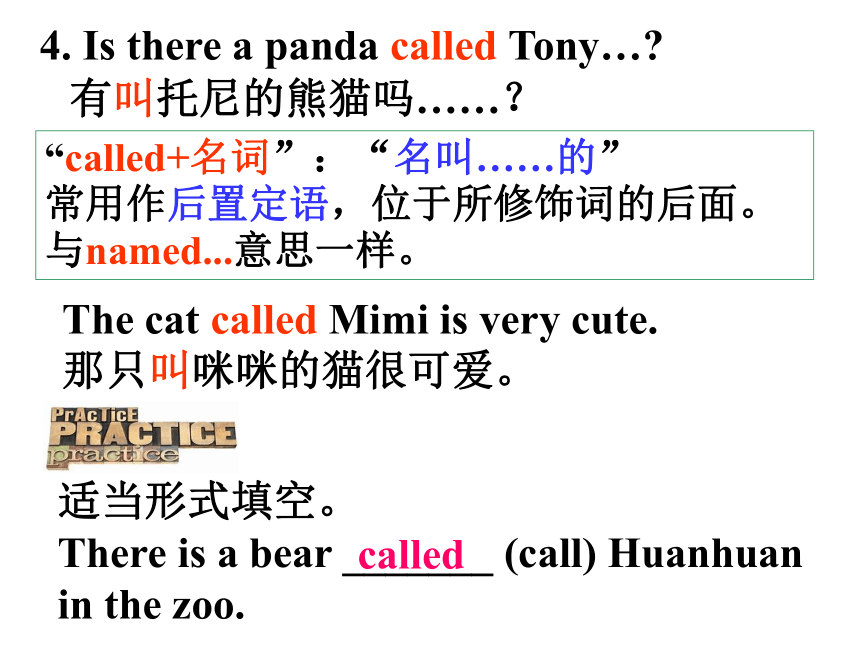
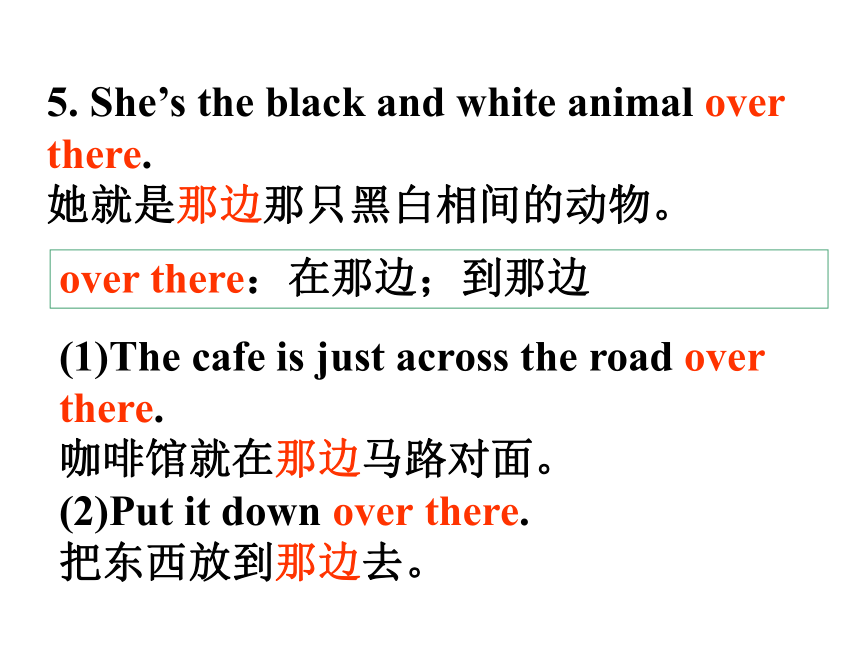
文档简介
(共13张PPT)
1. Welcome to Beijing Zoo.
欢迎来到北京动物园。
welcome to+地点 “欢迎来到某地”
Language points
Unit 1
(1) Welcome to our school for a visit.
欢迎来我们学校参观。
(2) Welcome to my home to have dinner.
欢迎到我家来吃饭。
welcome to +地点+for…
=welcome to+地点+to do sth
“欢迎来某地做某事”
2. The zoo has many kinds of animals, such as bears, zebras, giraffes and pandas.
1) kind 作名词,意为“种类”。
这个动物园里有许多种猴子。
There are ______ ______ ____ monkeys in the zoo.
many kinds of
动物园里有许多动物,比如熊,斑马,长
颈鹿和熊猫。
many kinds of +名词 :“许多种类的……”
相关短语:
a kind of 一种
all kinds of 各种各样的
different kinds of 不同种类的
2) such as 意为“比如,例如”,后面跟所列举的事物,用于列举同类事物中的几个列子。
(1) I have many hobbies (爱好), such as
reading and singing.
我有许多爱好,比如读书和唱歌。
(2) There are many animals in Asia, such as pandas, elephants, monkeys and tigers.
亚洲有很多动物,比如熊猫、大象、猴子和老虎。
“Shall we+动词原形 ” “……好吗 ”用于提出建议或征求对方的意见 。
-Shall we go to the zoo this afternoon
-Yes, let’s go.
—我们今天下午去动物园好吗?
—好的,我们一起去。
3. -Shall we go and see them
-Yes, let’s go.
—我们去看它们(熊猫)吧?
—好的,走。
肯定回答常用:
“Yes, let’s…./OK./Good idea./Sure.”
否定回答常用:“No, let’s…”
4. Is there a panda called Tony…
“called+名词”:“名叫……的”
常用作后置定语,位于所修饰词的后面。
与named...意思一样。
The cat called Mimi is very cute.
那只叫咪咪的猫很可爱。
适当形式填空。
There is a bear _______ (call) Huanhuan in the zoo.
called
有叫托尼的熊猫吗……?
5. She’s the black and white animal over there.
她就是那边那只黑白相间的动物。
over there:在那边;到那边
(1)The cafe is just across the road over
there.
咖啡馆就在那边马路对面。
(2)Put it down over there.
把东西放到那边去。
Language points
1. The elephant lives in Africa and in Asia.
大象生活在非洲和亚洲。
the elephant:指大象这个群体,而非某一头特定的大象。
英语中“the+名词的单数形式”: 可以用于泛指,表示“一类事物”,等同于名词的复数形式。
(1) My favourite animal is the panda.
Unit 2
(2) The horse is a useful animal.
熊猫是我最喜爱的动物。
马是有用的动物。
= My favourite animals are pandas.
= Horses are useful animals.
2. It eats plants and a little fruit, but it doesn’t eat meat.
它吃植物,也吃一点水果,但是不吃肉。
a little修饰不可数名词,意为“一点儿,少量”,表肯定。
little表示“很少的,几乎没有的”,表否定。其反义词是much。
(1) There is a little milk in the bottle.
瓶子里有一点儿牛奶。
(2) There is little milk in the bottle.
瓶子里几乎没有牛奶。
3. The panda eats about 30 kilos of bamboo a day as well as other plants.
除植物外,熊猫每天要吃大约30公斤的竹子。
as well as意为“也,还”,常用来连接并列的单词或短语,一般重点在前半句。
(1) He knows English as well as Chinese.
除了汉语,他还懂英语。
(2) She likes pandas as well as giraffe.
除了长颈鹿,她还喜欢熊猫。
4. It usually lives alone.
(老虎)常独居。
alone 作副词,意为“独自地”,表示客观数量上就一个,不具有感彩。
The old man lives there alone.
这个老人单独住在那儿。
(2) Don’t leave a child alone in a room with an open fire.
房间里有明火时,不要让孩子独处其中。
5. It likes water and is good at swimming.
老虎喜欢水,是游泳高手。
be good at + 名词/代词/V-ing
= do well in… “擅长…”
I’m good at learning English.
= I do well in learning English.
我擅长学习英语。
翻译句子。
我哥哥擅长打篮球。
Practice
My brother is good at playing basketball.
=My brother does well in playing basketball.
6. The black and white animal is the favourite of people all over the world.
这些黑白相间的动物是世人的最爱。
all over the world: 全世界
(1)The company ships its goods all over the world.
公司把货物运往世界各地。
(2)We have friends all over the world.
我们的朋友遍天下。
1. Welcome to Beijing Zoo.
欢迎来到北京动物园。
welcome to+地点 “欢迎来到某地”
Language points
Unit 1
(1) Welcome to our school for a visit.
欢迎来我们学校参观。
(2) Welcome to my home to have dinner.
欢迎到我家来吃饭。
welcome to +地点+for…
=welcome to+地点+to do sth
“欢迎来某地做某事”
2. The zoo has many kinds of animals, such as bears, zebras, giraffes and pandas.
1) kind 作名词,意为“种类”。
这个动物园里有许多种猴子。
There are ______ ______ ____ monkeys in the zoo.
many kinds of
动物园里有许多动物,比如熊,斑马,长
颈鹿和熊猫。
many kinds of +名词 :“许多种类的……”
相关短语:
a kind of 一种
all kinds of 各种各样的
different kinds of 不同种类的
2) such as 意为“比如,例如”,后面跟所列举的事物,用于列举同类事物中的几个列子。
(1) I have many hobbies (爱好), such as
reading and singing.
我有许多爱好,比如读书和唱歌。
(2) There are many animals in Asia, such as pandas, elephants, monkeys and tigers.
亚洲有很多动物,比如熊猫、大象、猴子和老虎。
“Shall we+动词原形 ” “……好吗 ”用于提出建议或征求对方的意见 。
-Shall we go to the zoo this afternoon
-Yes, let’s go.
—我们今天下午去动物园好吗?
—好的,我们一起去。
3. -Shall we go and see them
-Yes, let’s go.
—我们去看它们(熊猫)吧?
—好的,走。
肯定回答常用:
“Yes, let’s…./OK./Good idea./Sure.”
否定回答常用:“No, let’s…”
4. Is there a panda called Tony…
“called+名词”:“名叫……的”
常用作后置定语,位于所修饰词的后面。
与named...意思一样。
The cat called Mimi is very cute.
那只叫咪咪的猫很可爱。
适当形式填空。
There is a bear _______ (call) Huanhuan in the zoo.
called
有叫托尼的熊猫吗……?
5. She’s the black and white animal over there.
她就是那边那只黑白相间的动物。
over there:在那边;到那边
(1)The cafe is just across the road over
there.
咖啡馆就在那边马路对面。
(2)Put it down over there.
把东西放到那边去。
Language points
1. The elephant lives in Africa and in Asia.
大象生活在非洲和亚洲。
the elephant:指大象这个群体,而非某一头特定的大象。
英语中“the+名词的单数形式”: 可以用于泛指,表示“一类事物”,等同于名词的复数形式。
(1) My favourite animal is the panda.
Unit 2
(2) The horse is a useful animal.
熊猫是我最喜爱的动物。
马是有用的动物。
= My favourite animals are pandas.
= Horses are useful animals.
2. It eats plants and a little fruit, but it doesn’t eat meat.
它吃植物,也吃一点水果,但是不吃肉。
a little修饰不可数名词,意为“一点儿,少量”,表肯定。
little表示“很少的,几乎没有的”,表否定。其反义词是much。
(1) There is a little milk in the bottle.
瓶子里有一点儿牛奶。
(2) There is little milk in the bottle.
瓶子里几乎没有牛奶。
3. The panda eats about 30 kilos of bamboo a day as well as other plants.
除植物外,熊猫每天要吃大约30公斤的竹子。
as well as意为“也,还”,常用来连接并列的单词或短语,一般重点在前半句。
(1) He knows English as well as Chinese.
除了汉语,他还懂英语。
(2) She likes pandas as well as giraffe.
除了长颈鹿,她还喜欢熊猫。
4. It usually lives alone.
(老虎)常独居。
alone 作副词,意为“独自地”,表示客观数量上就一个,不具有感彩。
The old man lives there alone.
这个老人单独住在那儿。
(2) Don’t leave a child alone in a room with an open fire.
房间里有明火时,不要让孩子独处其中。
5. It likes water and is good at swimming.
老虎喜欢水,是游泳高手。
be good at + 名词/代词/V-ing
= do well in… “擅长…”
I’m good at learning English.
= I do well in learning English.
我擅长学习英语。
翻译句子。
我哥哥擅长打篮球。
Practice
My brother is good at playing basketball.
=My brother does well in playing basketball.
6. The black and white animal is the favourite of people all over the world.
这些黑白相间的动物是世人的最爱。
all over the world: 全世界
(1)The company ships its goods all over the world.
公司把货物运往世界各地。
(2)We have friends all over the world.
我们的朋友遍天下。
同课章节目录
- Module 1 Lost and found
- Unit 1 Whose bag is this?
- Unit 2 Are they yours?
- Unit 3 Language in use
- Module 2 What can you do ?
- Unit 1 I can play the piano
- Unit 2 I can run really fast
- Unit 3 Language in use
- Module 3 Making plans
- Unit 1 What are you going to do at the weekends?
- Unit 2 We're going to cheer the players.
- Unit 3 Language in use
- Module 4 Life in the future
- Unit 1 Everyone will study at home
- Unit 2 Every family will have a small plane.
- Unit 3 Language in use
- Module 5 Shopping
- Unit 1 What can I do for you?
- Unit 2 You can buy everything on the Internet
- Unit 3 Language in use
- Module 6 Around town
- Unit 1 Could you tell me how to get to the Nationa
- Unit 2 The London Eye is on your right.
- Unit 3 Language in use
- Revision module A
- Module 7 My past life
- Unit 1 I was born in a small village.
- Unit 2 I was born in Quincy.
- Unit 3 Language in use
- Module 8 Story time
- Unit 1 Once upon a time….
- Unit 2 Goldilocks hurried out of the house.
- Unit 3 Language in use
- Module 9 Life history
- Unit 1 He left school and began work at the age of
- Unit 2 He decided to be an actor.
- Unit 3 Language in use
- Module 10 A holiday journey
- Unit 1 What did you do?
- Unit 2 This morning we took a walk.
- Unit 3 Language in use
- Module 11 Body language
- Unit 1 They touch noses!
- Unit 2 Here are some ways to welcome them.
- Unit 3 Language in use
- Module 12 Western music
- Unit 1 It's so beautiful!
- Unit 2 Vienna is the centre of European classical
- Unit 3 Language in use
- Revision module B
